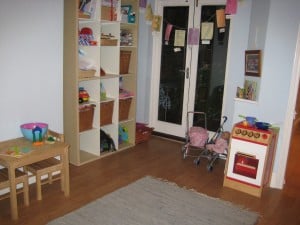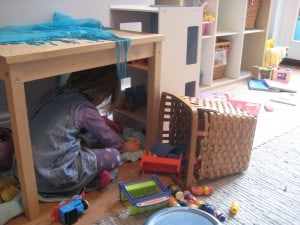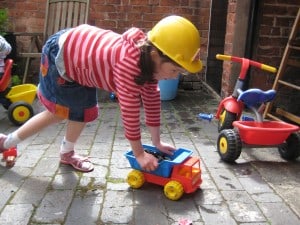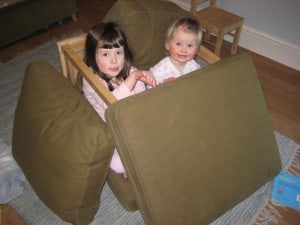So here we are on 1st January and, after helping the children with theirs yesterday, I’ve been thinking about what resolutions I’m making myself, especially about how I can nurture my family this year. Over at notimeforflashcards Allie has been rounding off an inspirational year with a review of her most popular posts from 2009, and in number one spot she’s sent out a call to ‘Let them play‘. This got me thinking that letting children play is really the most important thing we can do to nurture their learning. I believe children learn best by doing (not just watching or listening) and giving them the space to be creative and explore is vital. Filling their weeks with non-stop activities isn’t the way I want to spend 2010.
So, here are my suggestions for making 2010 the Year of Play in your home:
 1. Make an enabling environment. If you can arrange the play space in your house so that your children can access toys independently it means they are able to be in charge of their own play and use their imagination. We have open shelving in our play-room, with toys sorted into baskets with photos on to show what’s inside. This means that if my daughter is playing with her toy dog and needs some wooden blocks to build a kennel she knows exactly where they are to include in her play.
1. Make an enabling environment. If you can arrange the play space in your house so that your children can access toys independently it means they are able to be in charge of their own play and use their imagination. We have open shelving in our play-room, with toys sorted into baskets with photos on to show what’s inside. This means that if my daughter is playing with her toy dog and needs some wooden blocks to build a kennel she knows exactly where they are to include in her play.
2. Provide open-ended resources. I like to  provide different props to spark play ideas and I favour open-ended resources. So I’d rather give them wooden blocks, fir cones and sea shells, and different scarves and fabrics which they can use in anyway they want rather than a ‘toy’ which runs on batteries and only does one type of thing when you press a button.
provide different props to spark play ideas and I favour open-ended resources. So I’d rather give them wooden blocks, fir cones and sea shells, and different scarves and fabrics which they can use in anyway they want rather than a ‘toy’ which runs on batteries and only does one type of thing when you press a button.
3. Let them have freedom to play their way. So, I know that a jigsaw should be put together to make a nice picture but my daughter wants to put the pieces in a saucepan and ‘cook’ them. Is she wrong? Of course not, and if you encourage this child-led play you’re giving you child valuable space to explore what’s important and interesting to them.
4. Sit back and watch. Taking the time to really observe how your child is playing gives a window into what they’re ready to learn. By watching you can find out what they’re really interested in and use that as a springboard for other activities to develop their knowledge and understanding. Maybe they’re spending a lot of time playing with cars and you realise that it’s the circular motion of the wheels that’s fascinating them. You could then offer them some balls and a ramp to explore, or make a windmill together. Children don’t learn things in isolation but instead link together information and experiences. So if your child has been playing with a toy farm, combining this with a visit to a real farm, making a tractor from a big cardboard box and reading stories and singing songs songs all about animals is a very effective way to nurture their learning.
5. Sneak in the English, maths and science. Of course it’s important to incorporate these in your child’s world but this shouldn’t be instead of play. Therefore, your job is to ditch the flashcards and in their place include numbers and letters almost without the children realising. If they’re playing ‘shops’ you can make an ‘Open / Shut’ sign for the door and price tags for the produce. When you’re having a teddy bears’ picnic you can count how many plates you need. Adding different sized funnels and buckets to the sandpit or at bathtime lets them explore different volumes. And growing a sunflower in the garden is a great way to introduce biology.
How about you? What will your focus be for nurturing your children in 2010 – I’d love to hear your plans.
Happily shared with ABCand123’s Let’s Get Organised




Evaluate.
Since every home is different we need to look more at what is working and what isn’t. Observe, change and adapt. Keep things simple. A toy doesn’t need to have 5 functions but our children need to be able to do more than one thing with the toy 🙂
See the freedom in mess.
play is creativity; it is messy; it spills around the house; cannot be controlled, directed, defined; an adult cannot explain it nor should seek to. When a child plays they move backward and forward over the boundary between reality and fantasy. we need artists, poets, thinkers, creators in our society, and it starts in free-range play.
It’s funny you should write about this…Hubby and I were just discussing much the same goal for the coming year. We are looking forward to spending more one on one time with our girls and creating memories that will last forever.
I love how your advice about promoting free-range play (great term, grit) dovetails with democratic parenting’s philosophy of giving your child the means to do things for him or herself.
I once saw some really bad advice intended to keep your kids’ playspace tidy – that you should keep all the toys in a cabinet accessible only by you, and whenever your kid wanted to play with a different toy they had to trade in one of the toys that were out! Not only does that stifle all kinds of creative play, but it eliminates the possibility of you sitting down for a nice, uninterrupted cup of tea while they’re engrossed in something!
Great post!
Amy- I wonder if I wrote that post about having toys in a cupboard… I hope it wasn’t one of mine. We do have toys in a closet in our play room but it’s open 90% of the time, and closed only when I am not in the room(when I wrote it my son was 2 and I was often in the room with him, even if we weren’t playing together).
I beleive in rotating toys, never saying no to a toy request but we have SOOO many that I limit them some so he’s not overwhelmed. When too much is out he doesn’t play at all, rather he dumps things and then gets frustrated. Limiting doesn’t mean only placing one or two toys out, just finding that balance between fun and frustration.
That said with the rare exception of permanent markers nothing is really off limits at our house – his favorite toys today were the swiffer, his dad’s belt and a shopping cart. Together they made a garbage truck of course!
Thanks for your comments ladies. I definitely think you have to embrace a bit of mess. Mostly we have a tidy-up-time at the end of each day but sometimes it’s good to leave out a play area so they can use it again the next day. Our sofa stayed as a boat for a while, but it’s a caravan today. (We have a play room so they can use the sofa in there for play without us all having to sit on the floor!)
Allie, I keep lots of toys out of the way in the utility room and rotate things in and out too. Kids need physical space don’t they, so like you say it’s a question of balance.
And grit, I love the idea of having free-range kids.
hi! i didn’t invent that term, although i’d like to claim the credit! i think it’s um, quite normal in some circles, isn’t it? or the circles i move in…!
we also had a problem with every toy out on the floor when the kids were aged about 2 or 3 and it was total chaos – well beyond the mess stage! more like ‘see how quick we can break a limb and knock out daddy’.
i started to mould the house differently for messy play in some areas (including giving up a bathroom for total water and paint exploration) and reorganised to allow a mix of control / autonomy.
anyway, i just wanted to say i really like the idea of 2010 as the idea of play and am just about to blog about it and link here. so thank you again!
Wow, really fantastic tips! I like the idea of Year of Play and of raising awareness of how kids like to play and ways of encouraging/supporting their play. Im here from the Carnival, glad I found you!
Great post!
I wish I could find a balance between some level of organization and the enabling environment. Our house is tiny and the kids’ room is overflowing. We just donated some toys to good will.
The best thing I’ve got going is a shelf I got from a daycare that is double-sided and on wheels. Toddler toys on the front, tiny legos/big kid toys on the back against the wall. My son can roll out the shelf to get his things but toddler can’t.
I guess I shouldn’t be so uptight about the puzzles though. 😉
Hi Claudia – thanks for your comment. It’s lovely to know someone likes my ideas. Hope you’ll come back and visit again soon.